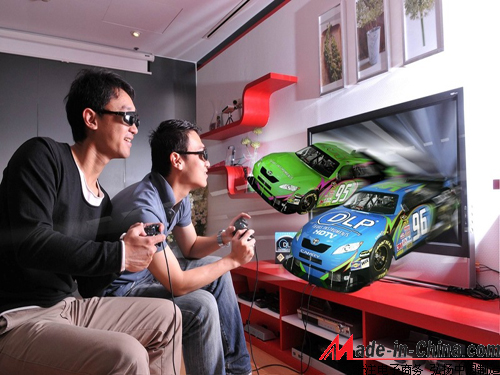 After years of rapid development, the growth momentum of flat-panel televisions has slowed down significantly due to pressures such as increased cost pressures, reduced consumer demand, and reduced purchasing power. In this slowing trend, 3D TVs have become the industry's life-saving straw.
After years of rapid development, the growth momentum of flat-panel televisions has slowed down significantly due to pressures such as increased cost pressures, reduced consumer demand, and reduced purchasing power. In this slowing trend, 3D TVs have become the industry's life-saving straw. Despite this, 3D TVs still have several shortcomings. These problems are difficult to solve in a short period of time and require the joint efforts of the entire industry and even the upstream and downstream industries to breed mature and effective solutions.
First of all, the lack of program content is the biggest weakness of the development of 3D TV. Many consumers were introduced or bought by manufacturers to buy home 3D TVs. They didn't know what to use or how to use them. There were neither 3D TV channels nor 3D video discs. The 3D function is actually an additional function with very little practical value for the television. Even some products claim to be able to convert 2D programs into 3D effects, which is truly a fantasy, and the results shown are difficult to satisfy. From this point of view, 3D TV is still notorious.
At present, there are still a lot of video content vendors watching the development of 3D TVs, which makes the resolution of bottlenecks in 3D TV content even more distant. Taking the booming Blu-ray player market in the domestic market as an example, in just two or three years, the Blu-ray disc player has fallen below 10,000 yuan from 10,000 yuan, and the abundant supply of Blu-ray discs at tens of yuan is sufficient. The Blu-ray disc player has quickly become popular in large and medium-sized cities. Just as the success of Blu-ray is the success of the entire industry chain, it also hopes that more 3D content manufacturers can boost the hardware manufacturers of 3D TVs, and only the positive interaction between the industry can promote the development of the 3D industry and even its related industries.
Secondly, 3D TV's harm to health is relatively obvious, and from a technical point of view, it cannot be completely avoided at present. With 3D display technology, after decades of development in the film industry, there are still many technical problems that cannot be solved. For example, a considerable proportion of viewers will feel dizzy, headache, and nausea when they watch. Currently, with the opportunity of the global hot release of "Avatar" at the beginning of last year, it is quickly transplanted into TV products. These technical defects will become even more serious.
Furthermore, the "fighting and fighting" between 3D TV manufacturers is too serious. 3D TV display technology currently has active shutter type, polarization type, naked-eye type and so on. Several technologies with their own obvious technical defects attack each other all day, and it is difficult for consumers to have an objective purchase basis. At present, these technologies have their own strengths, but also have their own defects, and because 3D technology is still developing, it is unknown whether or not it can occupy a large share of the market in the future. If consumers have rushed to buy 3D TVs with one of these technologies, it is likely that they will face the danger of technology being eliminated several years later.
Finally, the 3D TV industry lacks uniform industry standards and national standards. Because the 3D TV technical standards have not been unified, the same problems exist in the upstream and downstream industries of 3D TVs. In the 3D program shooting, editing, production, compression, transmission, storage, display formats, etc., different manufacturers are independent, easy to form an industry The waste of input. In view of this, the state has some technical problems to be solved urgently for the formulation of 3D standards. Upstream and downstream manufacturers in the 3D industry chain also have expectations and wait for the formulation of national standards. Due to the lack of uniform standards, there are many flat-panel TVs on the market with low refresh rate, poor color reproduction, and weak image layering. The 3D effects are poor, but these pseudo 3D TVs are popular in home appliance chain stores. The concept confuses a group of consumers.
In general, 3D display technology offers a concept of adding value-added products to the flat-panel TV industry with a lower profit margin, which is helpful for the development of the entire television industry. However, at present, some TV manufacturers have driven the immature pseudo-3D TV market to consumers in the interest of interest. This practice that ignores the future development of the entire industry will fundamentally ruin the future of the entire 3D TV.
Nylon Expandable Braided Sleeving
Description of Nylon Expandable Braided Sleeving For Wire Harness
Nylon expandable braided cable sleeve is sleeved by the ROHS polyester silk knitting .It has a good scalability, flame retardant, wear resistance and thermal insulation. Product surface are smooth, brightly-colored, great variety. Products are widely used in computer power cord, audio-video, automotive, aviation , wire and cable industries, It has protect and beautify the cables. Others can be customized according to customer demands including a variety of colors,patterns and all kinds of UV fluorescence color.
1. PA 6.6 Material, Light Weight & Flexible.
2. ecpandable type,Easy to Install, remove.
even if some with bulky or large connectors.
3. Abrasion Resistant and Flame redardant.
4. Totally expanded the sleeving can reach at least one point five times than the initial dimension.
Nylon Pa66 Sleeve,Black Nylong Sleeve ,Cable Management Sleeve,Black Wire Cable Sleeve
Shenzhen Huiyunhai Tech.Co.,Ltd , https://www.hyhbraidedsleeve.com
